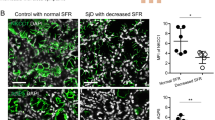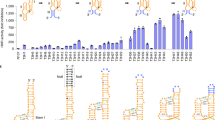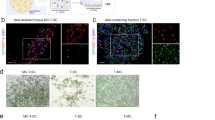Abstract
Gene transfer to the major salivary glands is an attractive method for the systemic delivery of therapeutic proteins. To date, nonviral gene transfer to these glands has resulted in inadequate systemic protein concentrations. We believe that identification of the barriers responsible for this inefficient transfection will enable the development of enhanced nonviral gene transfer in salivary glands and other tissues. One potential barrier is the degradation of plasmid DNA by endonucleases. To test this hypothesis, we coadministered two endonuclease inhibitors ((zinc and aurintricarboxylic acid (ATA)) with plasmid DNA, containing the secreted alkaline phosphatase gene (SEAP), to the submandibular glands of rats. The effect of zinc and ATA on SEAP expression, tissue accumulation of plasmid DNA, and plasmid DNA stability was then characterized. We observed that mixtures containing zinc/DNA, ATA/DNA, and zinc/ATA/DNA significantly enhanced both systemic transgene expression and the amount of plasmid DNA associated with treated tissues. The relative endonuclease inhibitory activity of zinc, ATA, and zinc/ATA correlated with the observed effects on transfection efficacy. The use of zinc/ATA enhanced the efficacy of salivary gland transfection by at least 1000-fold versus DNA alone. Importantly, this improved performance resulted in robust systemic secretion of an exogenous protein (SEAP), thus demonstrating the potential this nonviral gene transfer technology has as a method to treat systemic protein deficiencies.
This is a preview of subscription content, access via your institution
Access options
Subscribe to this journal
Receive 12 print issues and online access
$259.00 per year
only $21.58 per issue
Buy this article
- Purchase on Springer Link
- Instant access to full article PDF
Prices may be subject to local taxes which are calculated during checkout






Similar content being viewed by others
References
Isenman L, Liebow C, Rothman S . The endocrine secretion of mammalian digestive enzymes by exocrine glands. Am J Physiol 1999; 276: E223–E232.
Hoque AT, Baccaglini L, Baum BJ . Hydroxychloroquine enhances the endocrine secretion of adenovirus-directed growth hormone from rat submandibular glands in vivo. Hum Gene Ther 2001; 12: 1333–1341.
He X et al. Systemic action of human growth hormone following adenovirus-mediated gene transfer to rat submandibular glands. Gene Therapy 1998; 5: 537–541.
Baum BJ, Wellner RB, Zheng C . Gene transfer to salivary glands. Int Rev Cytol 2002; 213: 93–146.
Baum BJ et al. Polarized secretion of transgene products from salivary glands in vivo. Hum Gene Ther 1999; 10: 2789–2797.
Niedzinski EJ et al. Zinc enhancement of nonviral salivary gland transfection. Mol Ther 2003; 7: 396–400.
Bouchie A . Avigen AAV trial continues. Nat Biotechnol 2002; 20: 109.
Marshall E . Clinical research. Gene therapy a suspect in leukemia-like disease. Science 2002; 298: 34–35.
Baccaglini L et al. Cationic liposome-mediated gene transfer to rat salivary epithelial cells in vitro and in vivo. J Gene Med 2001; 3: 82–90.
Pichon C et al. Zinc improves gene transfer mediated by DNA/cationic polymer complexes. J Gene Med 2002; 4: 548–559.
Krieser RJ, MacLea KS, Park JP, Eastman A . The cloning, genomic structure, localization, and expression of human deoxyribonuclease IIbeta. Gene 2001; 269: 205–216.
Takeshita H et al. Mammalian deoxyribonucleases I are classified into three types: pancreas, parotid, and pancreas-parotid (mixed), based on differences in their tissue concentrations. Biochem Biophys Res Commun 2000; 269: 481–484.
Zollner EJ, Klepsch DM, Zahn RK, Knepper R . Deoxyribonuclease in human parotid saliva. Enzyme 1975; 19: 60–64.
Glasspool-Malone J, Malone RW . Marked enhancement of direct respiratory tissue transfection by aurintricarboxylic acid. Hum Gene Ther 1999; 10: 1703–1713.
Glasspool-Malone J, Somiari S, Drabick JJ, Malone RW . Efficient nonviral cutaneous transfection. Mol Ther 2000; 2: 140–146.
Glasspool-Malone J et al. DNA transfection of macaque and murine respiratory tissue is greatly enhanced by use of a nuclease inhibitor. J Gene Med 2002; 4: 322–332.
Sperinde JJ, Choi SJ, Szoka Jr FC . Phage display selection of a peptide DNase II inhibitor that enhances gene delivery. J Gene Med 2001; 3: 101–108.
Ross GF et al. Enhanced reporter gene expression in cells transfected in the presence of DMI-2, an acid nuclease inhibitor. Gene Therapy 1998; 5: 1244–1250.
Pollard H et al. Ca2+-sensitive cytosolic nucleases prevent efficient delivery to the nucleus of injected plasmids. J Gene Med 2001; 3: 153–164.
Lechardeur D et al. Metabolic instability of plasmid DNA in the cytosol: a potential barrier to gene transfer. Gene Therapy 1999; 6: 482–497.
Widlak P, Garrard WT . Ionic and cofactor requirements for the activity of the apoptotic endonuclease DFF40/CAD. Mol Cell Biochem 2001; 218: 125–130.
Torriglia A, Chaudun E, Courtois Y, Counis MF . On the use of Zn2+ to discriminate endonucleases activated during apoptosis. Biochimie 1997; 79: 435–438.
Niedzinski EJ et al. Zinc enhancement of nonviral salivary gland transfection. Mol Ther 2003; 7: 396–400.
Adesanya MR, Redman RS, Baum BJ, O'Connell BC . Immediate inflammatory responses to adenovirus-mediated gene transfer in rat salivary glands. Hum Gene Ther 1996; 7: 1085–1093.
Campbell VW, Jackson DA . The effect of divalent cations on the mode of action of DNase I. The initial reaction products produced from covalently closed circular DNA. J Biol Chem 1980; 255: 3726–3735.
Acknowledgements
We thank Professor Michael Nantz, Professor Stephen Rothman, and Professor Michael German for their advice and guidance during this study; and Dr Janice Bolaffi for editorial comments.
Author information
Authors and Affiliations
Rights and permissions
About this article
Cite this article
Niedzinski, E., Chen, YJ., Olson, D. et al. Enhanced systemic transgene expression after nonviral salivary gland transfection using a novel endonuclease inhibitor/DNA formulation. Gene Ther 10, 2133–2138 (2003). https://doi.org/10.1038/sj.gt.3302125
Received:
Accepted:
Published:
Issue Date:
DOI: https://doi.org/10.1038/sj.gt.3302125
Keywords
This article is cited by
-
Plasmid DNA is internalized from the apical plasma membrane of the salivary gland epithelium in live animals
Histochemistry and Cell Biology (2012)
-
Intrathecal Injection of Naked Plasmid DNA Provides Long-term Expression of Secreted Proteins
Molecular Therapy (2009)
-
DNA/Amphiphilic Block Copolymer Nanospheres Promote Low-dose DNA Vaccination
Molecular Therapy (2009)
-
Optimization of an electroporation protocol using the K562 cell line as a model: role of cell cycle phase and cytoplasmic DNAses
Cytotechnology (2006)
-
Salivary glands and gene therapy: the mouth waters
Gene Therapy (2004)



